Friday, August 17
• Once again, four bright planets remain in view as twilight fades all week. From right to left, they're Venus very low in the west-southwest, Jupiter in the southwest (upper left of Venus), Saturn in the south about as high as Jupiter, and bright Mars lower in the southeast. Best view: about 40 minutes after sunset.
• This evening the first-quarter Moon poses to the upper left of Jupiter. Antares is three times as far to the Moon's lower left.
• A mere 0.6° below Jupiter (about the width of a chopstick at arm's length) is 3rd-magnitude Alpha Librae, a wide double star for binoculars. Its fainter component, 4 arcminutes to the right of the bright one, is magnitude 5.1. That's only a little brighter than Jupiter's moons — which good binoculars will also show, lined up just to the big planet's left and right. Jupiter remains close to Alpha Librae all week.
Saturday, August 18
• Lined up nearly vertically below the Moon this evening are the stars marking the head of Scorpius. Lower left of the Moon is brighter Antares, one of the brightest orange-red supergiant stars in the sky.
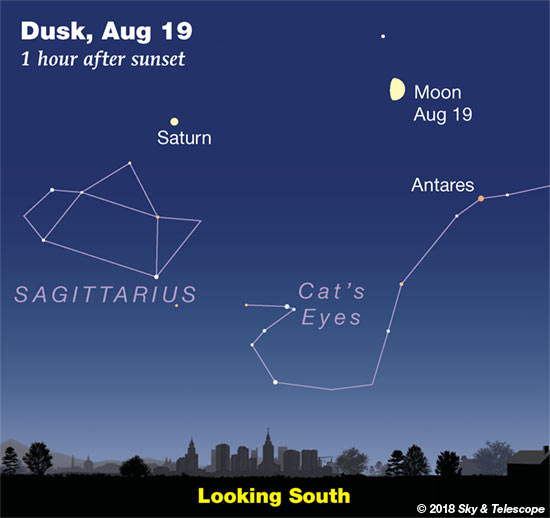
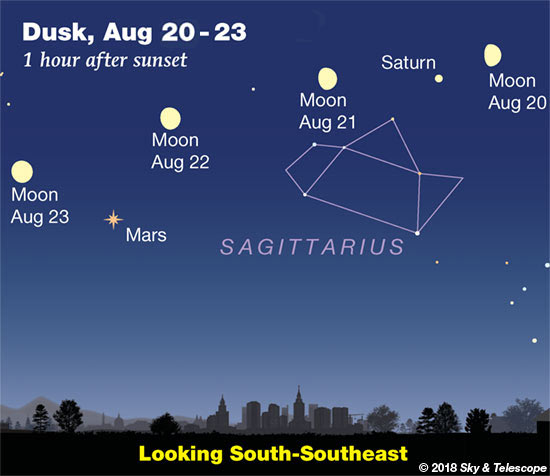
Sunday, August 19
• Now Antares is lower right of the Moon at nightfall, and Saturn glows to the Moon's left, as shown here.
Monday, August 20
• Saturn is the "star" left of the Moon this evening, as shown below right.
Tuesday, August 21
• Now Saturn glows to the Moon's right at dusk. And Mars shines farther to the Moon's lower left.
Wednesday, August 22
• The waxing gibbous Moon shines upper right of Mars this evening. Unlike Mars, the Moon lies in a nearly straight line with Saturn, Jupiter, and Venus (running from the right of the Moon very far to the west). To see how straight this line really is, hold a yardstick or a tightly stretched string along it. Why is this so? The Moon is nearly on the ecliptic tonight, but Mars is a good 6.1° south of the ecliptic.
Thursday, August 23
• Now Mars is lower right of the Moon, as shown above.
Friday, August 24
• After dark as August nears its end, the Great Square of Pegasus looms up in the east, balancing on one corner. Its stars are only 2nd and 3rd magnitude. Extending leftward from the Square's left corner is the main line of the constellation Andromeda, made of three stars (including the corner) about as bright as those forming the Square.
This whole giant pattern was named "the Andromegasus Dipper" by the late Sky & Telescope columnist George Lovi. Shaped sort of like a giant Little Dipper with an extra-big bowl, it currently lifts its contents upward.
Saturday, August 25
• Full Moon tonight and tomorrow (it's exactly full at 7:56 a.m. August 26th Eastern Daylight Time). This evening the Moon shines far left of Mars; they're on opposite sides of Capricornus.
________________________
Want to become a better astronomer? Learn your way around the constellations! They're the key to locating everything fainter and deeper to hunt with binoculars or a telescope.
This is an outdoor nature hobby. For an easy-to-use constellation guide covering the whole evening sky, use the big monthly map in the center of each issue of Sky & Telescope, the essential guide to astronomy.

Once you get a telescope, to put it to good use you'll need a detailed, large-scale sky atlas (set of charts). The basic standard is the Pocket Sky Atlas (in either the original or Jumbo Edition), which shows stars to magnitude 7.6.
Next up is the larger and deeper Sky Atlas 2000.0, plotting stars to magnitude 8.5; nearly three times as many. The next up, once you know your way around, are the even larger Interstellarum atlas (stars to magnitude 9.5) and Uranometria 2000.0 (stars to magnitude 9.75). And read how to use sky charts with a telescope.
You'll also want a good deep-sky guidebook, such as Sue French's Deep-Sky Wonders collection (which includes its own charts), Sky Atlas 2000.0 Companion by Strong and Sinnott, or the bigger Night Sky Observer's Guide by Kepple and Sanner.
Can a computerized telescope replace charts? Not for beginners, I don't think, and not on mounts and tripods that are less than top-quality mechanically (meaning heavy and expensive). And as Terence Dickinson and Alan Dyer say in their Backyard Astronomer's Guide, "A full appreciation of the universe cannot come without developing the skills to find things in the sky and understanding how the sky works. This knowledge comes only by spending time under the stars with star maps in hand."
This Week's Planet Roundup
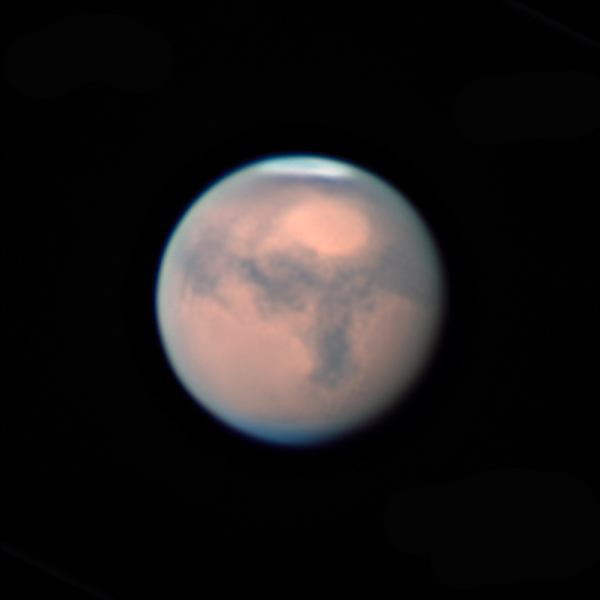
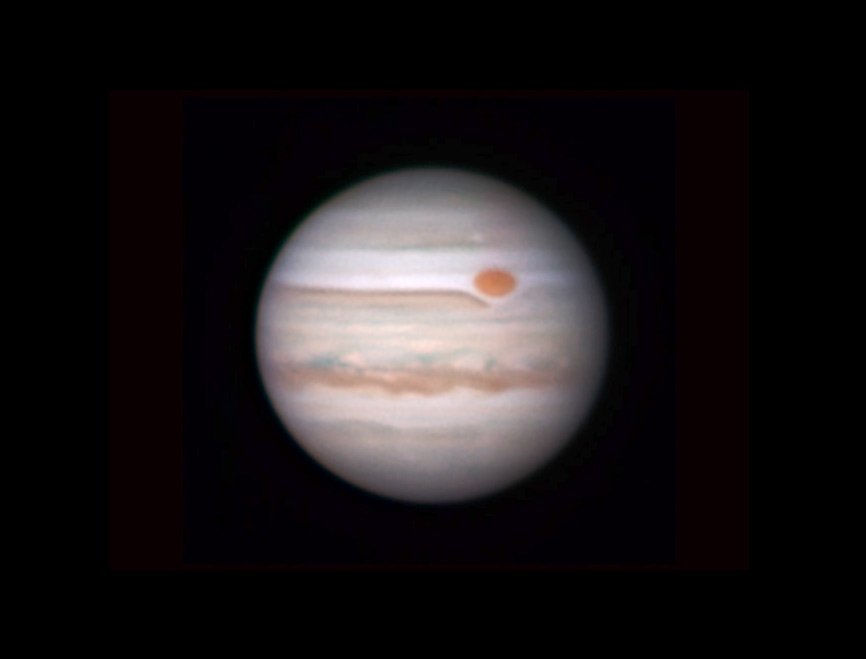
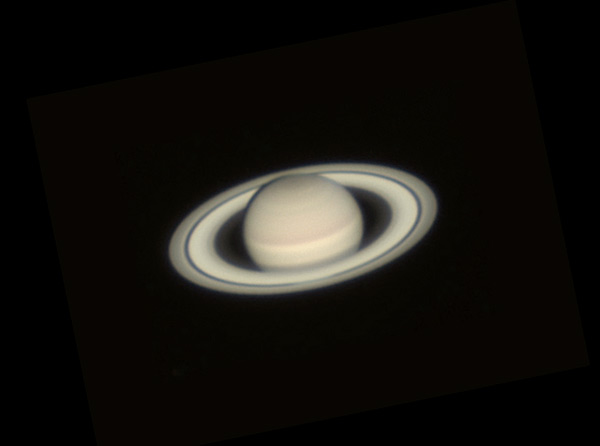
Mercury is deep in the glow of sunrise.
Venus (magnitude –4.5) shines low in the west in twilight. In a telescope Venus is just on the crescent side of dichotomy (half-lit) and has grown to 26 arcseconds tall. For the best telescopic seeing catch Venus as early as you can, preferably long before sunset while it is still high.
Mars is gradually fading; it diminishes from magnitude –2.5 to –2.3 this week. On the other hand, it rises higher in the southeast earlier in the evening and is at its highest in the south around 11 p.m. daylight-saving time. (Although it's not very high for us mid-northern observers; it's at declination –26°, at the border of Capricornus and Sagittarius). Mars shrinks from 23 to 22 arcseconds wide this week, while the dust in its atmosphere continues to thin. Take advantage of Mars this large while you still can! It won't appear this big again until 2035.
For a Mars map that shows which side is facing Earth at your time and date, use our Mars Profiler.
Jupiter (magnitude –2.0, in Libra) shines in the southwest in twilight. It's about 32° upper left of low Venus. Find Mars-colored Antares about 25° to Jupiter's left.
Saturn (magnitude +0.3, above the spout of the Sagittarius Teapot) glows yellow in the south at nightfall. It's about 23° left or upper left of Antares, and about 27° right or upper right of Mars.
Uranus (magnitude 5.8, at the Aries-Pisces border) and Neptune (magnitude 7.8, in Aquarius) are well up in the east and southeast, respectively, by midnight or 1 a.m. Finder charts for Uranus and Neptune.
______________________
All descriptions that relate to your horizon — including the words up, down, right, and left — are written for the world's mid-northern latitudes. Descriptions that also depend on longitude (mainly Moon positions) are for North America.
Eastern Daylight Time (EDT) is Universal Time (also called UT, UTC, GMT, or Z time) minus 4 hours.
______________________
"Remember to look up at the stars and not down at your feet. Try to make sense of what you see and wonder about what makes the universe exist. Be curious."
— Stephen Hawking, 1942–2018
______________________
"The dangers of not thinking clearly are much greater now than ever before. It's not that there's something new in our way of thinking, it's that credulous and confused thinking can be much more lethal in ways it was never before."
— Carl Sagan, 1996
______________________
"Objective reality exists. Facts are often determinable. Vaccines save lives. Carbon dioxide warms the globe. Bacteria evolve to thwart antibiotics, because evolution. Science and reason are not a political conspiracy. They are how we determine facts. Civilization's survival depends on our ability, and willingness, to do this."
— Alan MacRobert, your Sky at a Glance editor
______________________
"Facts are stubborn things."
— John Adams, 1770
 16
16








Comments
Rod
August 17, 2018 at 2:42 pm
"Friday, August 17"
I observed Jupiter, Alpha Librae double star and the waxing crescent Moon last night using binoculars (near 2130 EDT), Jupiter and Alpha Librae in same field of view. I tracked the position changes of Jupiter approaching Alpha Librae double star with my telescope since 06-Aug as they got closer and closer in the sky. Very interesting planetary motion along with the Galilean moon position changes to observe. On 29-May-18, Jupiter moved retrograde in Libra within one degree of Alpha Librae passing the double star, now it is moving eastward past the double star. Jupiter ended retrograde motion 11-Jul and began east motion again. Very interesting to watch this dance with the double star.
You must be logged in to post a comment.
mary beth
August 17, 2018 at 3:37 pm
Very interesting. I started noticing the Alpha Librae Double Star in May but didn’t notice it again until last week, Do you happen to know the furthest they were a part in between their conjunctions? Thank you.
You must be logged in to post a comment.
Jakob
August 17, 2018 at 3:55 pm
Check Bob King' article may 9th. "Jupiter shines with a mighty light" 🙂
You must be logged in to post a comment.
mary beth
August 18, 2018 at 1:37 am
Great article! Would not have seen it, thank you for recommdation!
You must be logged in to post a comment.
Rod
August 17, 2018 at 10:16 pm
mary beth, I checked MS WWT for 11-Jul-18 at 2130 EDT. Jupiter was about 2 degrees or so to the west of Alpha Librae double star when Jupiter stopped retrograde motion and began eastward motion in Libra. Jupiter is now passing Alpha Librae again as it continues eastward in Libra. I keep detailed observations like this in my stargazing log. I know some folks who like flat earth *science* - they are all geocentric folks. My detailed telescope observations confound them 🙂
You must be logged in to post a comment.
mary beth
August 18, 2018 at 1:42 am
Rod, thank you for taking the time to answer so thoroughly. Your log tell such a story, I don’t see how anyone could not be interested in Plato’s “spindle of necessity”! Makes me wonder how often Jupiter has taken a similar path over the centuries…
You must be logged in to post a comment.
Jakob
August 17, 2018 at 3:49 pm
At 21:14 local time I saw the four planets with unaided eyes. Saturn was the most difficult because of the bright sky(sun 5° below horizon). Venus and Mars just 2° over. Jupiter near our moon were an easy task (-:
You must be logged in to post a comment.
mary beth
August 18, 2018 at 1:43 am
Sounds beautiful! What is your latitude?
You must be logged in to post a comment.
Jakob
August 18, 2018 at 11:05 am
Mary! I live in southern Sweden at 56°north. Helsingborg is my observation site. From where you are in Texas it should be easy to catch them all. I caught Venus at sunset. Jupiter 5 minutes later on. Mars were seen another 25 minutes later and when it was dark enough Saturn was seen as well. At 21:14 I could see all four planets (-:
You must be logged in to post a comment.
BLINKINGplanetaryWILL
August 17, 2018 at 9:16 pm
The planets have been great this Summer, it is like watching a parade across the southern facing sky. I will use them to adjust my focus then I am going to check out some harder targets in my sky. I am going to observe the Ring Nebula M57 tonight followed by M92. And if the humid weather permits I want to check out the North American Nebula NGC 7000. Oxygen-III filter here I come!
You must be logged in to post a comment.
Rod
August 18, 2018 at 10:20 am
Jakob, mary beth et al. If folks are interested, I track planetary motion and find Fred Schaaf, Sun, Moon & Planets report each month in Sky & Telescope magazine very useful. Jupiter began retrograde motion in Libra on 09-Mar-18, Jupiter ended retrograde motion in Libra 11-Jul-18. Mars began retrograde motion 28-Jun-18 in Capricornus, Mars ends retrograde motion 28-Aug-18 near border of Capricornus and Sagittarius, Saturn began retrograde motion 17-Apr-18 in Sagittarius, Saturn will end retrograde motion 06-Sep-18. I use a 90-mm refractor with 1.25 inch focuser and a 10-inch with 2-inch focuser and 1.25 inch ability. It is great fun to observe and record so much celestial motion visible in the eyepiece. Jupiter's Great Red Spot rotating by, Galilean moons orbiting, Saturn's 5 moons visible in the 10-inch moving around Saturn and the rings, Mar's rotation, and yes sunspot observing and tracking across the face of the Sun. Even the Sun's changing angular size in the eyepiece from season to season is visible too. I keep my observations updated in MS ACCESS DB for quick use.
You must be logged in to post a comment.
Jakob
August 18, 2018 at 11:15 am
Rod! Keep up the Good work 🙂
You must be logged in to post a comment.
mary beth
August 19, 2018 at 11:27 pm
Rod, I am going to subscribe to S&T and read the article you recommended. Thank you. I appreciate all the information you gave us about the planets this summer. Do you have a dark viewing area?
You must be logged in to post a comment.
Rod
August 20, 2018 at 8:39 am
mary beth you asked "Do you have a dark viewing area?" My answer is yes - mostly but no desert sky. I live along the Patuxent River Valley farms in Maryland, horse and alpaca country and legal hunting areas, farms 10-100 acres or so and some State wildlife managed game preserve protected areas too. In the June issue of Sky & Telescope on page 54, Sue French reported on the double star Nu1 and Nu2 Coronae Borealis, mv + 5.4 and mv +5.6. I can still see the double star with my unaided eye. There are no street lights where I am at and I use my telescopes on my horse farm, my neighbor has 50 acre horse farm nearby - no lights around and sometimes I observe from that location too. Most of my viewing is to the east in the direction of the Chesapeake Bay area and south sky. West and north is more light polluted areas. Carrying 80 lbs. or more of telescope equipment out into horse pastures more than 100 yards walk, can be a good light work out 🙂
You must be logged in to post a comment.
mary beth
August 23, 2018 at 11:22 pm
Rod, sounds like a good life! I love the Corona Borealis but I can only see Alphecca. The light pollution has gotten worse in the last few years, I used to be able to make out the the curve. Hope you have clear skies for the full moon! Sounds like you have a lot of nature to enjoy it out there.
You must be logged in to post a comment.
Rod
August 24, 2018 at 3:08 pm
mary beth, thanks. Last night (Thursday) was great for August where I am at. Cool front came through and clear skies with temps hovering 60. The waxing gibbous Moon lit up the fields and woods all around near 2200 EDT. I used my 10-inch telescope and enjoyed some great views of Mars and Saturn at 216x. Earlier this morning, I used my 90-mm refractor and enjoyed some views of sunspot AR2719. I use spaceweather.com to track sunspot reports to view. Next week the temps go back into the low 90s with yucky humidity and warmer nights.
You must be logged in to post a comment.
You must be logged in to post a comment.